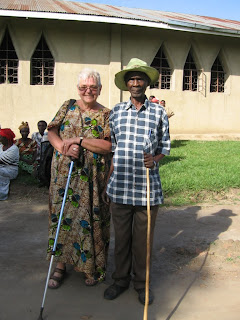
This photo was taken just before the end of this year's workshop. Kitambaa and friends had a last photo taken before packing up the Round House, taking down the quilts, putting the supplies away for another year, and then attending to our own packing. We are bringing back a fair supply of fabric (surprise, surprise!), as well as beads and necklaces, batiks and baskets, and other treasures. Also 72 shirts made by the Bitengye Designers for the Victoria Children's Choir, and samples of all the other "new fashions" made this year. Many items have already been sold, or left as samples in a number of venues. In less than a week we will be home again, and all of this will be a wonderful memory. Thank you, once again, to all of you who have been a part of this project. We hope to see many of you in the coming months, to show you updated photos, and most importantly the items made by the Bitengye Designers, the sale of which has made such a terrific difference in their lives.

























